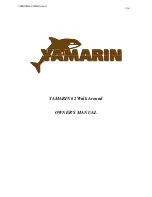
Emergencies
5-3
• Many fires are the result of gasoline and oil accumulating in the bilge, careless
fueling practices and electrical problems. In the event of a fire, try to stop the
boat and turn off the engine as quickly and safely as possible. Immediately use
a fire extinguisher at the base of the flames in a sweeping motion to reduce or
extinguish the fire. Ensure that all passengers are safe from immediate danger
and are wearing life jackets. If the fire is located in the engine compartment (if
equipped), make sure the bilge blower (if equipped) is off and do not open the
engine cover.
• Once you have extinguished the fire, check for other immediate fire threats and
personal injuries and call for assistance immediately.
• If you are unable to easily extinguish the fire, or if the fire is uncontrollable,
attempt to get yourself and all passengers off the boat and into the water. If
possible, ensure that all passengers are wearing life jackets or have access to
one by the time they are in the water. Before leaving the boat, if possible, verify
that there is no immediate danger of fuel sitting or burning on the water’s
surface where you and your passengers will be floating. Immediately swim to a
safe position upwind from the boat and use distress signals to get assistance.
USING DISTRESS SIGNAL DEVICES AND
CALLING FOR HELP
An emergency can occur when you least expect it. Be sure you and your
passengers know how to use all types of distress signaling devices. Seconds
count during emergencies. Knowing the proper way to use the distress signaling
devices on-board your vessel can help saves lives.
The word “MAYDAY” is the international signal of distress. Use “MAYDAY” only in
emergency situations.
In emergency situations and when lives are in danger, you may need to use
VHF-type two-way radios, cell phones and Emergency Position Indication Radio
Beacons (EPIRBs). Knowing the proper use and operation of these
communication devices is critical. Make sure you know what channels to use and
numbers to call. Know how to send an efficient and informative message about
your emergency to ensure that proper help and assistance can be provided.
Ensure all passengers understand how to operate all
on-board visual and audible distress signaling devices
and communication equipment. Keep all distress
signaling devices and communication equipment in a
readily accessible area and within immediate reach at
all times.
KC-0246C-B
Copyright 2019
Ken Cook Co.
All Rights Reserved
www.KenCook.com/marine
Summary of Contents for Fi21
Page 1: ...Centurion_Cover_2019_Layout 1 10 24 2018 9 48 AM Page 1...
Page 3: ...This Page Intentionally Left Blank...
Page 7: ...iv This Page Intentionally Left Blank...
Page 17: ...Section 1 1 10 This Page Intentionally Left Blank...
Page 27: ...Section 2 2 10 This Page Intentionally Left Blank...
Page 48: ...Safety 3 21 Figure 3 4 Figure 3 4 CNTRN 0050B A...
Page 68: ...Safety 3 41 Figure 3 10Centurion Ri237 Figure 3 13 Figure 3 11Centurion Ri217 Figure 3 14...
Page 69: ...Section 3 3 42 Figure 3 12Centurion Fi25 Figure 3 15 Figure 3 13Centurion Fi23 Figure 3 16...
Page 70: ...Safety 3 43 Figure 3 14Centurion Fi21 Figure 3 17...
Page 71: ...Section 3 3 44 This Page Intentionally Left Blank...
Page 131: ...Section 8 8 24 Fi23 Ballast Tank Locations Figure 8 22 Fi21 Ballast Tank Locations Figure 8 23...
Page 165: ...Section 10 10 10 This Page Intentionally Left Blank...
















































